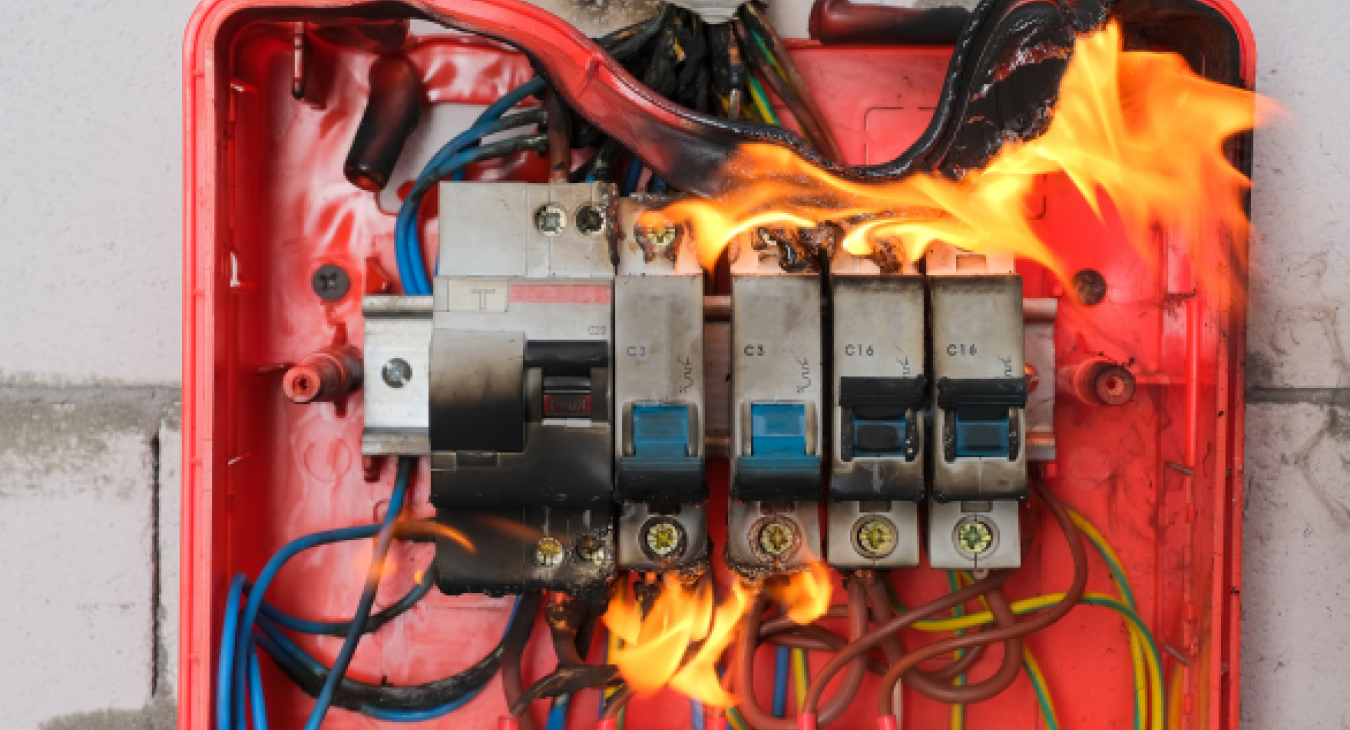Electrical Short Circuit, definition and causes - Electrical Faults Fixed
Table of Contents
- Electrical Short Circuit: Definition and Causes
- What is an Electrical Short Circuit?
- Parts of an Electrical Circuit
- Types of Electrical Short Circuits
- Common Causes of Short Circuits
- Signs of a Short Circuit
- Preventative Measures and Safety Measures
- The Role of Circuit Breakers in Preventing Short Circuits
- Electrical Repair and Maintenance
- Summary
1) Electrical Short Circuit: Definition and Causes
As an electrician and electrical lecturer, I am frequently asked by clients and students alike about electrical issues like: What is a short circuit and why such problems occur.
Electrical short circuits are among the most common causes of electrical problems in homes and commercial properties. Understanding what an electrical short circuit is, the potential causes, and how to prevent it is essential for ensuring electrical safety. In this article, we look at the definition of an electrical short circuit, the common causes, signs of damage, and safety measures that can help keep you safe and your electrical system functioning correctly.
Back to top2) What is an Electrical Short Circuit?
An electrical short circuit occurs when the electric current flows along an unintended path of low resistance connection instead of the intended circuit path. In a short circuit condition, the flow of electricity takes the path of least resistance, which can lead to excessive current flow and potential damage to electrical appliances, devices, and property. Short circuits can cause high temperatures, electrical fires, and electric shock, which is why they require immediate attention.
Back to top3) Parts of an Electrical Circuit
To understand how a short circuit happens, it is important to know the basic components of an electrical circuit:
- Live wire (Line Conductor or hot wire): Carries the electrical power from the power source (such as the electrical panel) to the electrical equipment.
- Neutral wire: Completes the circuit by carrying the current back to the power supply.
- Ground or Earth wire: Provides a safe path for electricity to flow back to the ground (earth) in case of a fault or ground fault.
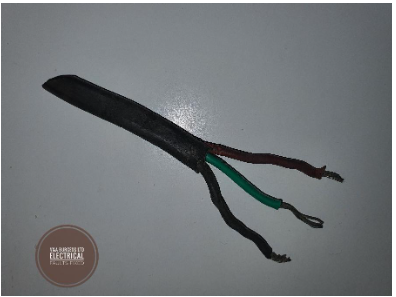
(Old wiring colours in an old rubber cable)
Under normal operating conditions, electrical current flows along the Line (or HOT wire) conductor, passes through an appliance, light bulb or other electrical equipment and returns via the Neutral conductor. Electrical equipment like this provides an impedance or resistance to current flow and minimises the level at which electrical current can rise to.
When the live conductors come into direct contact with each other or with the ground wire, a short circuit current is generated, creating a potential hazard.
Back to top4) Types of Electrical Short Circuits
There are different types of short circuits, and each type depends on the cause of the short circuit and the electrical connections involved:
Normal Short Circuit: Occurs when a hot wire comes into contact with a neutral wire, resulting in a low-resistance path that causes a high current flow.
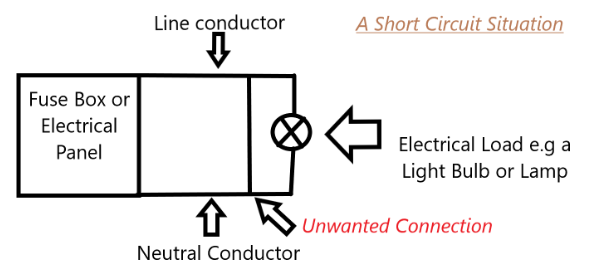
Ground Fault: Happens when a hot wire touches a ground wire or a metal object connected to the ground, leading to a dangerous situation where electricity flows through the human body or other conductive paths.
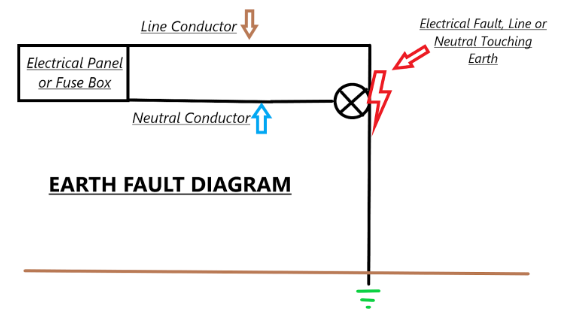
- Arc Fault: Caused by damaged wires, loose wire connections, or broken wire insulation, which leads to an electrical arc that can ignite nearby flammable materials. Arc-fault circuit interrupters (AFCIs or AFDD) are designed to detect these faults and cut off power to prevent electrical fires.
Back to top
5) Common Causes of Short Circuits
Several factors can cause a short circuit in a home’s electrical system. Below are the most common causes of short circuits:
- Faulty Wiring: One of the primary reasons for short circuits is faulty wiring or wiring problems. Poor-quality electrical connections, loose connections, or damaged insulation can lead to unintended connections between the wires, creating a low-resistance path and a short circuit.
- Loose Wire Connections: Loose connections in electrical components, such as in switches, outlets, and service panels, can lead to sparking and short circuits. Regular electrical inspections by a licensed electrician can help detect these issues early.
- Faulty Appliance Wiring: Electrical appliances and electrical devices with damaged or faulty appliance wiring can cause short circuits. This can happen when the power cords or internal wiring deteriorate or become exposed, resulting in a direct contact between wires.
Metal Objects: Inadvertently inserting a metal object like a nail or screw into an electrical outlet or wiring can cause a short circuit. The metal provides an alternative low-resistance path, resulting in a high current flow.
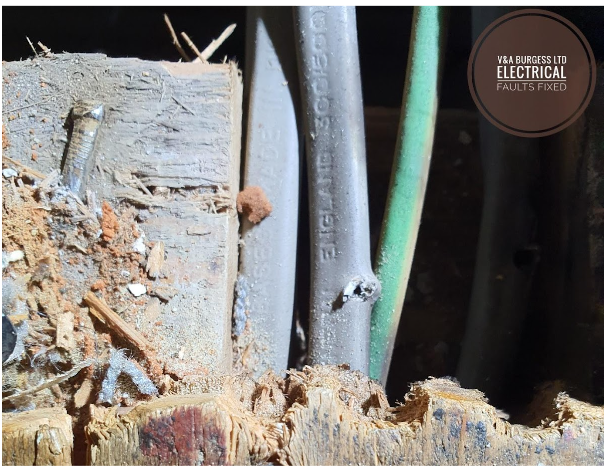
(Photo: Cables damaged under floorboards by screws)
- Water and Moisture: Water is a good conductor of electricity, and exposure to water or moisture can create a short circuit condition. This is especially common in areas like bathrooms and kitchens. GFCI outlets (Ground Fault Circuit Interrupters) should be used in these areas to prevent electrical shocks.
6) Signs of a Short Circuit
Locating and fixing a short circuit is necessary for preventing considerable damage to the electrical system and possible property damage. Common signs of a short circuit are:
- Burn Marks: Scorch marks or burn marks around outlets or switches indicate a short circuit.
- Tripped Breaker: A circuit breaker that frequently trips is a sign of a short circuit. When the breaker trips, it prevents high current flow to protect the electrical system.
- Electrical Shock: A direct contact with an energized surface can lead to an electric shock, indicating a fault.
Unusual Odors or Sparks: Burning smells or visible sparks near outlets or wiring suggest a short circuit or another serious electrical fault.
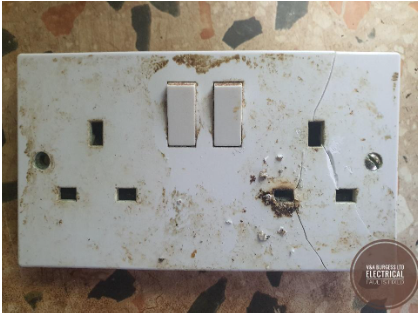
7) Preventative Measures and Safety Measures
Prevention is the first step in avoiding electrical faults and ensuring electrical safety. Here are some preventative measures:
- Regular Electrical Inspections: Hire a licensed electrician to inspect the electrical panel (consumer unit, fuse box), wiring, and all electrical connections regularly to detect and fix potential hazards before they escalate. See electrical repair and maintenance below.
- Install AFCI and GFCI Outlets: Installing arc-fault circuit interrupters (AFCIs) and GFCI outlets in key areas can help prevent electrical fires and electric shock by cutting off the power supply during faults.
- Repair Faulty Wiring and Appliances: If you notice any signs of damage, such as frayed power cords or faulty wiring, get them repaired immediately by a professional.
- Avoid Overloading Circuits: Do not overload outlets with too many electrical appliances or devices. Overloaded circuits can lead to overheating, high currents, and electrical fires.
- Keep Water Away from Electrical Equipment: Ensure that electrical devices are kept away from water sources. Use waterproof covers for outdoor outlets to protect against moisture.
8) The Role of Circuit Breakers in Preventing Short Circuits
Circuit breakers play a vital role in any home’s electrical system. They are designed to cut off power to a circuit if it detects an excessive current flow. When a breaker trips, it stops the flow of electricity, preventing further damage to the electrical components and the risk of fire. Tripped breakers are a common occurrence when a short circuit is detected.
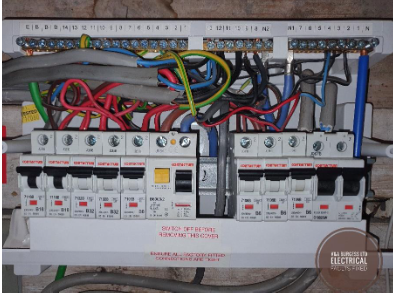
Circuit breakers will trip in one of two ways:
Overload - When too many electrical appliances are used and the circuit breakers maximum operating current is exceeded. The circuit breaker contains a bi-metallic strip that makes the contact inside. As the circuit is used under normal conditions, this bi-metallic strip warms up and continues to make contact. As the level of electrical current increases with demand and exceeds the preset level inside the breaker, the strip, being made of two different metals, begins to bend and eventually breaks contact inside the circuit breaker. When this occurs, the electrical current flow is stopped and the switch for the breaker trips.
Electrical Fault Conditions - When a short circuit occurs, a very large electrical current occurs and the circuit breaker needs to trip more quickly to prevent damage. In these circumstances, the solenoid inside will detect the large fault current and operate more quickly than the bi-metallic strip.
Back to top9) Electrical Repair and Maintenance
Addressing electrical repair needs promptly can lengthen the life of the overall wiring system. If you suspect a short circuit or other electrical issues, do not attempt DIY fixes; instead, seek professional electrical services. Qualified electricians can troubleshoot electrical faults, repair loose wire connections, replace damaged wires, and ensure your home is safe from potential electrical hazards.
A good way of ensuring that your home is adequately protected is to have regular electrical checks carried out. As an electrician and teacher, I am often asked how often electrical systems should be checked to ensure safe operation and the answer depends upon the installation and use.
Domestic homes should be checked after they reach ten years of age and again every ten years. Where there are signs of deterioration in the electrical system it may be necessary to increase the frequency of electrical testing to monitor the condition of the electrical wires, equipment and system condition.
Back to top10) Summary
Understanding what an electrical short circuit is and the most common causes of short circuits can help homeowners take the necessary steps to prevent considerable damage and ensure electrical safety. Regular maintenance, safety measures, and awareness of the signs of damage will help in keeping your property safe from the dangers of short circuits and other electrical issues. Always consult a licensed electrician for electrical inspections, repairs, and installations to maintain a safe electrical system.
By being proactive and attentive to the signs of potential electrical faults, you can protect your home, your loved ones, and your property from the dangers of electric short circuits.
Read more articles
- Log in to post comments

